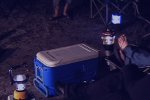I was wondering if anyone has some tips/tricks to night filming. I have an upcoming shoot, and I know it's silly, but don't really have any experience filming at night outdoors.
I'll be using two cameras. A Panasonic AD-DVC 7 and a Sony DSR-250. In a few days I'm going to do some site shooting and editing for practice. I would appreciate any help so I don't look like to much of a fool in front of my crew .
.
This is going to be a night-for-night shoot. I'm just grasping for basics and noodling around google not getting much help.
Thanks in advance! And I'll post my pitfalls/successes after the shoot.
I'll be using two cameras. A Panasonic AD-DVC 7 and a Sony DSR-250. In a few days I'm going to do some site shooting and editing for practice. I would appreciate any help so I don't look like to much of a fool in front of my crew
 .
.This is going to be a night-for-night shoot. I'm just grasping for basics and noodling around google not getting much help.
Thanks in advance! And I'll post my pitfalls/successes after the shoot.






